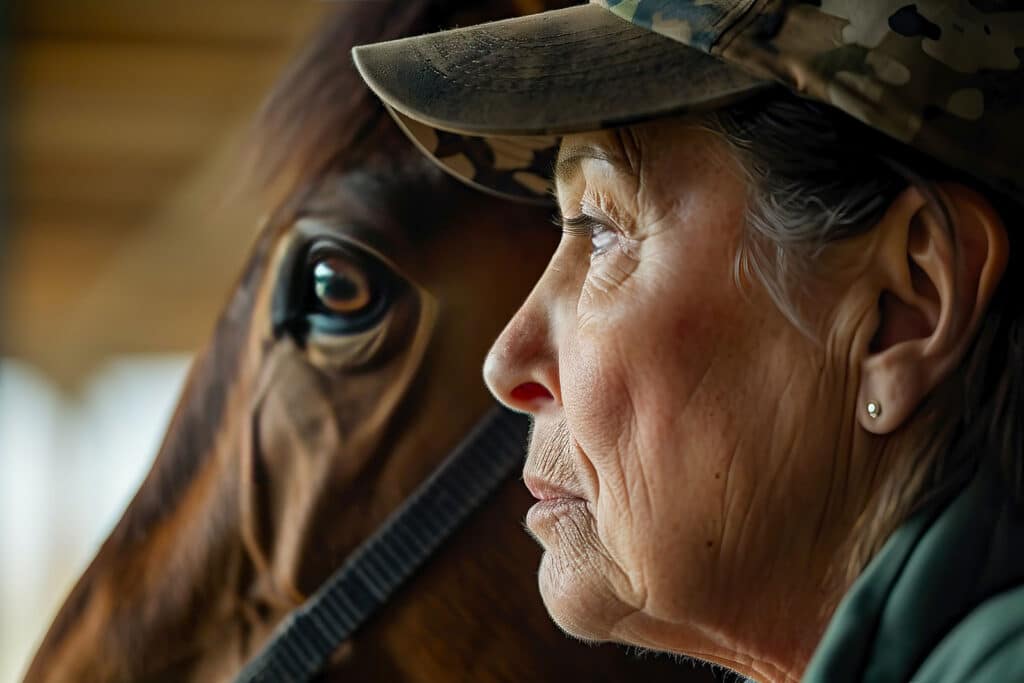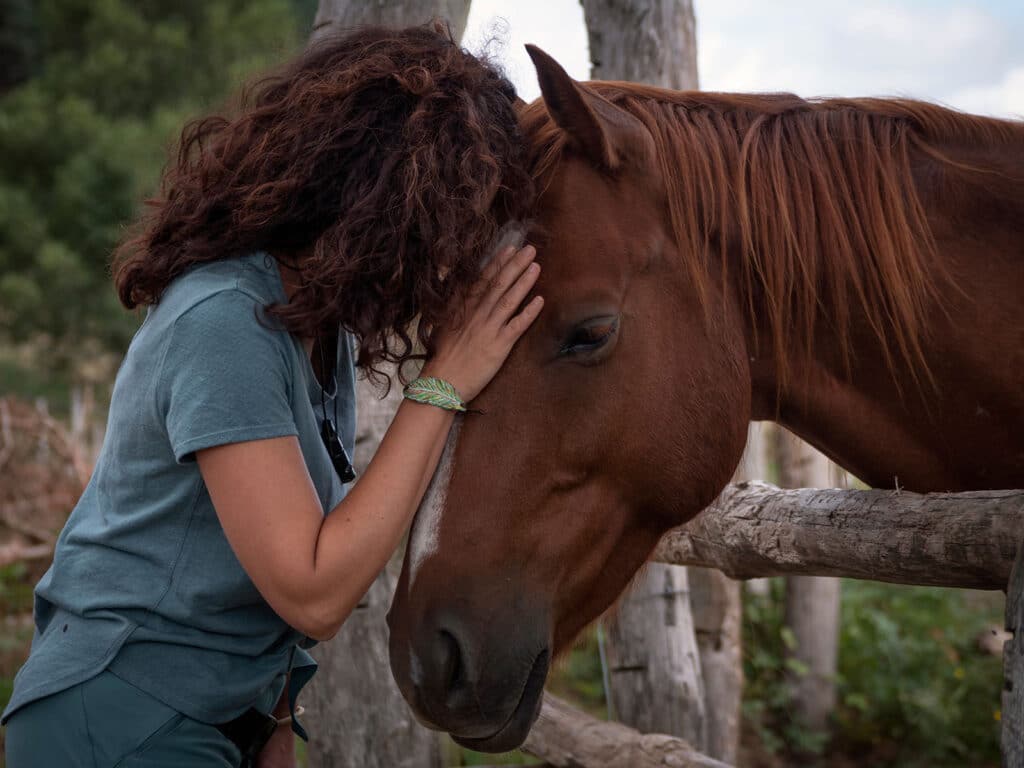As effective as the traditional therapeutic strategies are, they don’t always offer the coveted results when applied alone. Sometimes, a change of scenery is needed.
That’s where equine therapy comes in. Promoting healthy emotional regulation through deep connections, this complementary therapeutic modality has proven to be efficient and successful.

As a state famous for the spread of drug addiction and mental health disorders, applying equine therapy strategies in Florida would be an ideal scenario.
It would help that community with the numerous battles it’s fighting, allowing it to reach its full potential.
That’s what Recreate Life Counseling aims to do. So, let’s explore what this treatment can offer.
Table of Contents
Equine Therapy: An Overview
Equine therapy is a form of mental health treatment that prompts physical and cognitive well-being by forming a meaningful connection with a horse. The nature of that treatment differs from one program to another.
For example, some programs offer therapeutic riding for patients who need physical and occupational treatment. Others prohibit such activities, thinking it’d be too dangerous, and focus on equine-assisted learning instead.
However different each program is, they all focus on helping patients engage in peaceful activities, such as grooming, feeding, and walking the horses.
At first glance, interacting with a horse may seem like a bizarre method of treating mental health issues. The idea behind that approach is to teach patients to take care of animals.
Horses don’t just need food, water, and shelter. They also require attention, selflessness, and love to be properly taken care of.
Indulging in such therapeutic activity helps patients build empathy, self-esteem, and confidence, all of which are necessary in psychological treatment.
Of course, equine therapy sessions usually take place under the supervision of licensed equine specialists and professional horse trainers.

Why Use Horses for Psychological Support?
Although numerous animals can be used for therapeutic support, horses have proven to be the best companions for patients at that stage. Here’s why:
They Create a Calming Environment
As humans, we try to create a safe space for each other where we can be honest and vulnerable as much as we can. Unfortunately, no matter how much we try, some people will struggle to communicate the hardships they’re experiencing openly.
Well, the gentle, calm nature of horses creates a serene space for people to engage with them. They also react to their companions’ emotions with no bias or judgment.
When emotional challenges or previous experiences are challenging to share, externalizing them through horses helps lift that burden off patients’ shoulders.
They’re Vigilant and Sensitive
Horses are vigilant, observant creatures, capable of understanding the meaning behind your movements and emotions. They often convey that understanding to their human companions to help them feel safe.
Not only does this help patients feel understood, but it also makes them more self-aware of their behavior and how they convey emotions.
What Types of Equine Therapy Can Patients Engage In?
There are various types of equine-facilitated psychotherapy, and each has a different purpose and targets different diseases. The one most suitable for you depends on your state and the treatment you want to receive.
Therapeutic Riding
As the name suggests, therapeutic horseback riding teaches patients to control a horse while riding. It usually takes place under the supervision of a qualified riding instructor.

Riding targets people with special needs or disabilities that restrict their movements and the way they interact with others. That’s why it’s most common among people with cerebral palsy, autism, and Down syndrome.
Not only does riding help them gain the freedom of mobility they long for, but it also improves the following:
- Posture
- Balance
- Reflexes
- Self-control
- mindfulness
- Emotional control
- Coordination
Equine-Assisted Psychotherapy (EAP)
Equine-assisted psychotherapy involves using the horse as a tool for emotional support and stress relief. It’s different from riding because most equine-assisted activities involve groundwork, such as feeding, grooming, or walking the horse.
Equine-Assisted Learning (EAL)
Equine-assisted learning prompts patients to interact with horses to develop specific skills. For example, building a proper relationship with the horse where both parties understand each other improves their communication skills.
Learning how to take an assertive stance and prompt the horse to follow direct commands improves leadership skills.
Ultimately, it’s an environment that prompts self-development in a calm, enjoyable atmosphere.

What Conditions Can Equine Therapy Treat?
Psychiatrists use equine therapy to treat numerous types of physical and mental health issues. These include:
1. Substance Use Disorders (SUD)
Whether it’s cocaine, opioid, or marijuana, Florida has had a problem controlling its drug addiction rates for years. Well, implementing more equine therapy programs might help that problem.
Patients going through drug addiction treatment need communication, trust, and confidence. These are all skills they can develop through equine therapy.
That’s especially true for trust, as both parties rely on each other to have their physical and emotional needs fulfilled. interacting with horses and putting in the effort to care for them can also reduce stress levels.
A 2016 study covers the effectiveness of equine therapy in treating drug addiction. Kern-Godal et al. argue that this approach creates a stable environment that allows patients to develop a positive self-image. That increases their chances of finishing the treatment successfully.
Additionally, it gives them a break from the traditional SUD treatment atmosphere. Equine therapy usually takes place outdoors, which can easily improve patients’ mood and make them more open to the treatment.
2. Anxiety
Anxiety symptoms differ from one patient to another. However, most people experiencing chronic anxiety tend to worry about the past and the future.
Equine therapy can help reduce overthinking, as it forces anxiety patients to focus on the present to ensure they’re taking proper care of the horse. It’s an animal-based form of meditation.
Besides, horses can sense human emotions, such as fear and anxiety, and react accordingly. Numerous patients struggle with anxiety internally, without it being visible to their loved ones.
Interacting with these vigilant creatures helps them receive the empathy they deserve and might be looking for.
Additionally, building a connection with a horse is a new experience for most people. So, it prompts patients to step out of their comfort zone, which is always helpful in their fight against anxiety.

3. PTSD
Post-traumatic stress disorder (PTSD) is a disorder people develop after experiencing a shocking and traumatic event. Its symptoms often include:
- Distressing dreams or nightmares (usually about the traumatic event).
- Uncontrollable traumatic flashbacks.
- Recurrent, Involuntary memories.
- Lack of interest in activities that used to be enjoyable.
- Adopting self-destructive behavior.
Despite the severity of these symptoms, by far, the most destructive one is the inability to maintain meaningful bonds. PTSD patients are often numb to everything around them, including people.
That makes it difficult for them to form meaningful connections. So, having an empathetic, sensitive horse that allows them to be as vulnerable as they want by their side can speed up the healing process.
Many PTSD patients have stated that they never thought they could form healthy relationships again, but they did with equine treatment horses. Then, they were gradually able to build the same connection with people.
A 2023 systematic review examined numerous studies that covered the effectiveness of equine therapy in treating PTSD in the previous five years.
Researchers found that regardless of the type of equine intervention PTSD patients enrolled in, they all benefited from that treatment. Most of them have even shown signs of improvement within six months.
4. ADHD
Attention-deficit/hyperactivity disorder (ADHD) is a common neurodevelopmental disorder characterized by:
- Having trouble paying attention.
- Lack of impulse control.
- Constant daydreaming.
- Talking too much.
- Forgetting a lot of information.
- Losing personal objects all the time.
Unfortunately, these symptoms aren’t the most extreme on the list. ADHD patients usually struggle with emotional regulation.
Not knowing how an ADHD patient would react to certain events makes it hard for people to maintain long-lasting relationships with them.
Luckily, horse therapy can help with that. Horses respond openly and honestly to people’s emotions. So, patients can receive feedback they won’t easily get from other people and use that feedback to regulate their behavior.
Additionally, communicating with a horse involves paying attention to non-verbal cues, which can help ADHD patients manage their lack of focus.
A 2011 evidence-based study examined whether equine-assisted therapy can help children aged 10-11 with ADHD. Researchers gave these children a one-hour therapeutic horse riding session twice a week for two months.
At the end of the experiment, the children showed significant improvements in motor performance, social behavior, and quality of life.

What Happens During an Equine Therapy Session?
As previously established, equine therapy sessions differ from one program to another. However, you can always find common activities no matter what program you’ve enrolled in.
Keeping a Close Eye
Not all treatment programs allow patients to interact with the animals right away. Taking some time to watch the horses go about their day can help patients understand how they think and break the fear barrier they may have.
Starting with Simple Interactions
After breaking the fear barrier, patients can interact with the horses to start the treatment. That phase usually involves small gestures, such as grooming or feeding the horse.
Going on Walks
That’s one of the first crucial steps patients can take to form a healthy bond with the horses. It allows both parties to spend more time together and understand each other’s habits and emotions.
Riding Around the Premise
That’s the ultimate form of bonding between horses and humans. Riding horses properly indicates both parties can clearly communicate with each other, even without verbal cues.
That means they’ve managed to build a meaningful connection that can help these patients in their healing journey.
Conclusion
Ultimately, equine therapy can prompt emotional regulation, treating numerous mental health issues, such as ADHD, PTSD, SUD, and anxiety.
Whatever program you choose to enroll in, you want to appreciate the calming nature of the treatment and enjoy building a connection with your horse.
Please contact Recreate Life Counseling for additional information about Equine Therapy near you.



